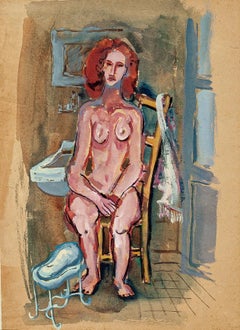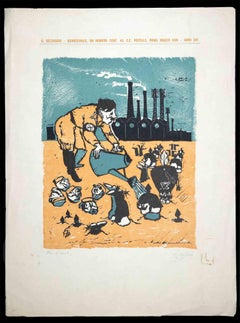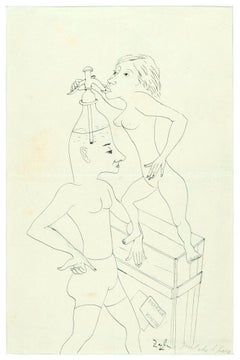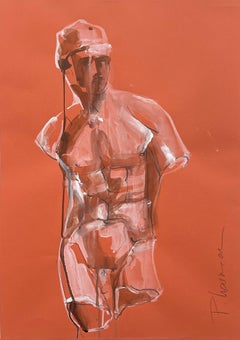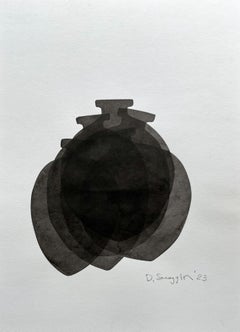Primo Zeglio Art
1906-1984
Primo Zeglio was an Italian film director and playwright, as well as a draftsman, painter and engraver. Between 1937–39, he collaborated with the weekly publication Omnibus, directed by Leo Longanesi, and worked with the artist Mino Maccari, who realized scathing satirical comic strips for Omnibus. Zeglio took part in the drafting of Italiano and Selvaggio and, especially from the 1970s, he dedicated himself mainly to painting and engraving.
to
3
3
3
1
1
1
Nude Woman - Original Tempera and Watercolor by Primo Zeglio - 1930s
By Primo Zeglio
Located in Roma, IT
Nude Woman is an original painting in watercolor and tempera realized by Primo Zeglio in 1930 ca. The state of preservation is good and aged, except for a small tear. signed on the rear.
Sheet dimension: 32 x 22 cm.
Included a Passepartout: 45 x 35 cm.
The artwork represents a nude seated woman in a bathroom, delicately colored, skillfully created, it is characterized by confident strokes and chiaroscuro effects to enhance the volumes of the nude body.
Primo Zeglio was an Italian film director and playwright, as well as a draftsman, painter, and engraver. Between 1937 and 1939, he collaborated with the weekly publication Omnibus, directed by Leo Longanesi...
Category
1930s Primo Zeglio Art
Materials
Ink, Tempera
The Cultivation of Dictators - Woodcut by Primo Zeglio - 1940s
By Primo Zeglio
Located in Roma, IT
The Cultivation of Dictators is an original woodcut print by Primo Zeglio in the 1940s.
Good conditions.
The artwork is depicted through strong strokes in a well-balanced composition.
Category
1940s Modern Primo Zeglio Art
Materials
Woodcut
Quel che ti pare (Whatever you Want)-Original Ink drawing by Primo Zeglio-1950s
By Primo Zeglio
Located in Roma, IT
Quel che ti pare is a satirical drawing realized by Primo Zeglio in the mid-XX century. The state of preservation is good, except for a small tear on the right margin and on the higher left corner. On the lower center, it is signed “Zeglio” in China ink, while “quel che ti pare” is written in pencil on the lower right. At the bottom of the drawing, “Biennale Venezia...
Category
1950s Primo Zeglio Art
Materials
Ink
Related Items
ENIGMA original art ink on colored paper Paula Craioveanu Neo Mythology
By Paula Craioveanu
Located in Forest Hills, NY
"Enigma", original ink and pencil on sepia paper. Part of Neo Mythology series. Shipped rolled in a tube.. Free shipping with 1stDibs code for items over $500.
Like the immortal myth...
Category
2010s Contemporary Primo Zeglio Art
Materials
Ink, Tempera, Paper
$400 Sale Price
20% Off
H 27.5 in W 19.5 in
Figurative Ink Painting N.1 'Vessels' by Dmitry Samygin
By Dmitry Samygin
Located in Paris, FR
Figurative Ink on Cotton paper
Painting N.1 'Vessels' by Dmitry Samygin
H.27 x 19.5 cm
About Dmitry Samygin
Furniture and Product Designer. His approach relies on simple forms and clarity in ideas with carefully chosen materials to expose the essence of an object. His products exemplify humanistic design, comfort in everyday use and ergonomic function.
He is a prize-winner in international competitions. He has taken part in exhibitions in Paris, Milan and Moscow, collaborates with European and Russian production, architectural and design companies. Since 2021 Dmitriy's design has been presented in a permanent exhibition at the Museum of Arts and Crafts in Moscow. Dmitry's graphics and designs are in private collections all over the world.
Samygin's Awards
2023 I+D / Design Now / winner (product design & decor)
2021 Red dot / Modul
2021 I+D magazine award / Shelter (covers for the sculptures of Moscow State Architectural Museum)
2020 Best 2020 AD Russia
2019 Andrew World...
Category
21st Century and Contemporary Contemporary Primo Zeglio Art
Materials
Cotton, Paper, Ink
$707
H 10.63 in W 7.68 in D 0.04 in
Figurative Ink Painting N.2 'Vessels II' by Dmitry Samygin
By Dmitry Samygin
Located in Paris, FR
Figurative Ink on Cotton paper
Painting N.1 'Vessels II' by Dmitry Samygin
H.27 x 19.5 cm
About Dmitry Samygin
Furniture and Product Designer. His approach relies on simple forms and clarity in ideas with carefully chosen materials to expose the essence of an object. His products exemplify humanistic design, comfort in everyday use and ergonomic function.
He is a prize-winner in international competitions. He has taken part in exhibitions in Paris, Milan and Moscow, collaborates with European and Russian production, architectural and design companies. Since 2021 Dmitriy's design has been presented in a permanent exhibition at the Museum of Arts and Crafts in Moscow. Dmitry's graphics and designs are in private collections all over the world.
Samygin's Awards
2023 I+D / Design Now / winner (product design & decor)
2021 Red dot / Modul
2021 I+D magazine award / Shelter (covers for the sculptures of Moscow State Architectural Museum)
2020 Best 2020 AD Russia
2019 Andrew World...
Category
21st Century and Contemporary Contemporary Primo Zeglio Art
Materials
Cotton, Paper, Ink
$707
H 10.63 in W 7.68 in D 0.04 in
Desire - original blue female nude by Paula Craioveanu inspired Matisse
By Paula Craioveanu
Located in Forest Hills, NY
"Desire", nude, ultramarine tempera on colored paper, inspired by Matisse. Part of Nude in Interior series.
Shipped rolled in a tube, Fast shipping anywhere in the world - 7 days.
En...
Category
2010s Contemporary Primo Zeglio Art
Materials
Tempera, Archival Paper
$525 Sale Price
25% Off
H 27.5 in W 19.5 in
Paris with Apples Neo Mythology by Paula Craioveanu
By Paula Craioveanu
Located in Forest Hills, NY
"Paris with Apples"
The original legend says Paris, prince of Troy had one golden apple, and had to choose between 3 goddesses.
Modern Paris has more than one apple, and he is depi...
Category
2010s Contemporary Primo Zeglio Art
Materials
Paper, Ink, Tempera
$400 Sale Price
20% Off
H 27.5 in W 19.5 in D 0.2 in
SILENCE - original large blue female nude by Paula Craioveanu 39x27.5in
By Paula Craioveanu
Located in Forest Hills, NY
"Silence", pencil and ultramarine tempera on paper, inspired by Matisse.
Part of Nude in Interior series.
Large drawing. Shipped rolled in a tube.
Size 39x27.5in /100x70cm
Free shi...
Category
2010s Contemporary Primo Zeglio Art
Materials
Tempera, Pencil, Archival Paper
$525 Sale Price
25% Off
H 39 in W 27.5 in
Wedding Party
Located in Buffalo, NY
An original mid century modern woodblock print.
This work is hand signed illegibly and titled "Wedding Party".
Category
1960s Modern Primo Zeglio Art
Materials
Paper, Woodcut
NIGHT BLUES - Female Nude original unique art by Paula Craioveanu
By Paula Craioveanu
Located in Forest Hills, NY
"Night Blues" Female Nude, seen from the back, and a second view in the mirror. from another perspective. Part of "Nude in Interior" series, inspired by Matisse. Ultramarine tempera ...
Category
2010s Contemporary Primo Zeglio Art
Materials
Tempera, Carbon Pencil, Rag Paper
$400 Sale Price
20% Off
H 27.5 in W 19.5 in D 1 in
SLICED VENUS - original large art by Paula Craioveanu 30x27in Neo Mythology
By Paula Craioveanu
Located in Forest Hills, NY
Sliced Venus. Original art, signed 100x70cm / 30x27in, ink, graphite, tempera on paper. large size, shipped rolled in a tube
Drawing has on the back 2 white wood sticks, and it's rea...
Category
2010s Contemporary Primo Zeglio Art
Materials
Tempera, Pencil, Ink, Archival Paper
$480 Sale Price
20% Off
H 39 in W 27.5 in
Peace
By Anton Refregier
Located in Fairlawn, OH
Peace
Woodcut printed in orange red ink on japanese paper
Signed and titled in pencil lower right (see photo)
Titled lower left (see photo)
Created along with an illustrated book project Song of Peace, 1950-1959.
Condition: Excellent
Image: 10 1/2 x 4 7/8"
Sheet: 16 1/8 x 7";
Anton Refregier (March 20, 1905 – October 10, 1979) was a painter and muralist active in Works Progress Administration Federal Art Project commissions, and in teaching art. He was a Russian immigrant to the United States.
Among his best-known works is his mural series The History of San Francisco, located in the Rincon Center in downtown San Francisco, California. It depicts the city's history across twenty seven panels that he painted from 1940 to 1948.
Life and early career
Refregier was born in Moscow and emigrated to the United States in 1920. After working various odd jobs in New York City, he earned a scholarship to the Rhode Island School of Design in 1921. After finishing school, Refregier moved back to New York in 1925. To earn a living, Refregier worked for interior decorators, creating replicas of François Boucher and Jean-Honoré Fragonard paintings...
Category
1950s American Modern Primo Zeglio Art
Materials
Woodcut
BOYS WILL BE BOYS original art Paula Craioveanu Male Nude Female Gaze
By Paula Craioveanu
Located in Forest Hills, NY
“Boys will be Boys”, male nude, tempera pencil charcoal on blue paper, 27.5x19.5in, 70x50cm.
Check 1stDibs free shipping code for items over $500. Shipped rolled in a tube, well pa...
Category
2010s Contemporary Primo Zeglio Art
Materials
Ink, Tempera, Archival Paper
$480 Sale Price
20% Off
H 27.5 in W 19.5 in
NIGHTWISH - female nude - by Paula Craioveanu -original art inspired by Matisse
By Paula Craioveanu
Located in Forest Hills, NY
“Desire”. Part of Blue Nude series, inspired by Matisse. Ultramarine tempera on paper. Comes with a certificate of authenticity signed by the artist. Shipped rolled in a tube 31x3in...
Category
2010s Contemporary Primo Zeglio Art
Materials
Paper, Tempera
$600
H 27.5 in W 19.5 in D 0.1 in
Primo Zeglio art for sale on 1stDibs.
Find a wide variety of authentic Primo Zeglio art available for sale on 1stDibs. You can also browse by medium to find art by Primo Zeglio in ink, paint, tempera and more. Much of the original work by this artist or collective was created during the 20th century and is mostly associated with the modern style. Not every interior allows for large Primo Zeglio art, so small editions measuring 7 inches across are available. Customers who are interested in this artist might also find the work of Frank Kleinholz, Jackson Lee Nesbitt, and Daniel Ginsbourg. Primo Zeglio art prices can differ depending upon medium, time period and other attributes. On 1stDibs, the price for these items starts at $635 and tops out at $2,106, while the average work can sell for $891.
